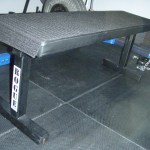So PZillaFX asked me on Youtube the other day to write a blog post detailing what I eat and what supplements I take.

Actually, he asks “how” but I’m going to assume he meant “what” because I’m sure he’s not interested in what type of utensils I use or how I chew my food etc.
And this seems to be a somewhat common question I get from a variety of places from time to time, so I might as well write a blog post about it.
Before I get started, there’s a few things I want to mention when it comes to my approach to eating and supplements.
1. First, if you didn’t know already, I’m 5’4” tall (or 163 cm) and fluctuate between roughly 200-205 lb (or 90.9-93.2 Kg).
I have gained a few pounds or so since eating like this (around late spring/early summer 2012), and right now my body weight is holding steady.
When I started taking barbell training seriously around late November of 2010, I was about 183 lb. I did not take any supplements except fish oil and a multivitamin.
I was living in Bangkok, Thailand until July 2011, and up until then, I only ate real food. Because food was cheap I ate out a lot.
This includes sushi buffet, pizza buffet, breakfast buffet (unlimited eggs and bacon!), Sizzler, KFC (ordered a family size bucket and ate this with rice), McDonalds, Outback Steakhouse, mango and sweet glutinous rice with coconut milk, Thai stewed pork leg with 5 spices and rice, Korean pork with rice, and a bunch of other stuff that I can't remember.
Trying to recall what and where I ate is making my mouth water as I write this.
I also had a slow cooker and rice cooker that was used on a regular basis. And I ate many bags of chips and drank a lot of pop (usually Coke Zero or Sprite Zero).
Man, I miss Thailand!
Back then, I also ate food before working out. Eating a big bowl of rice/meat/veggies before heading out to squat with a belt on was not comfortable.
When I came back from Thailand to Canada in July 2011, what I ate was more of the same (rice,meat,veggies). I just didn't eat out as often as I did before.
And this may come as a surprise to some people, but I only started taking whey protein around early January 2012 (I found an old receipt in my email to verify this), and creatine sometime early-April of 2012.
2. I don’t count calories or figure out what my “macros” are.
It just seems like a pain in the ass counting calories and trying to accurately figure out something that is at best, an approximation.
By the way, “macros” is a relatively new term for me. Previously I have known this word to be meant as something big (ex. macroeconomics, or macrophillia), something to do with programming, as in a macro in Excel, or something to do with photography.
Somehow, it has been adopted by the internet fitness world as a short form for “macronutrient”.
I like the long form of macronutrient better.
I mean, you wouldn’t call macroeconomics and microeconomics “macro 101” or “micro 101” right? Or maybe people do. I don’t know.
3. I am jaded by taking crappy supplements in the past that did nothing but burn a hole in my wallet and/or give me an upset stomach in the past.
I’m skeptical of marketing claims made by supplement companies and generally “stick to the basics” so I don’t take a whole lot of supplements. I prefer things that make a big impact, rather than some substance that claims a certain effect if you take it, but in reality, couldn’t really tell the difference between the “supplement” from a placebo.
I do take a multivitamin and fish oil, just in case. But that’s about it.
Anyway, I describe below what a normal day is when it comes to eating and supplements. I started eating this way around late spring or early summer of 2012.
The timestamps are approximations, so they vary from day to day.
6:30 AM - Morning Coffee With Whey Protein
I start my day off with some instant coffee and whey protein. I’ll add heaping teaspoon of instant coffee, and either half a scoop of whey protein if I’m using 1 flavor, or 2x 1/4 scoop if I’m using 2. I eyeball the quantity in the scoop so it’s not exact. I wrote an article describing exactly how I add whey protein to coffee here.

During this time I’m catching up on email, looking through my Facebook feed and RSS reader. Once that’s out of the way and the caffeine starts kicking in, I’ll try to do something productive.
I’ll go through 3 cups of coffee and total of about 1.5 scoops of whey protein.
9:30 AM – Make My Shake & Take Some Pills
Now, I make my pre-peri-post workout protein energy drink. I’ll add caffeine and sometimes ephedrine HCL into a shaker cup, mixed it up with water, followed by approximately 5g of creatine and 2 scoops of whey protein. Full details about how I make my protein energy drink is covered here.
I recently struck a deal with some nearly-expired Ultimate Nutrition Whey Sensation 81 whey protein for $9.99 for 2 lb. The flavors are cookies and cream, and chocolate truffle. So I’m mixing in 1 scoop of cookies and cream, and another scoop of chocolate truffle. Tastes ok, but the cookies and cream has actual cookie bits in there.
Also, at this time I’ll take a multivitamin and fish oil. I take these so that I’m not deficient in any vitamins and minerals, and I don’t eat fish at home and unfortunately I cannot eat sushi buffet everyday.

This is the cheapest multivitamin I could find. I even accidentally got the “adults over 50” version! It makes my urine neon yellow like the color of the Nike Romaleos 2 Volt shoes. Should be fine.
I don’t believe in taking super expensive, supposedly high quality multivitamins, simply because I’ve never found that it made any significant impact on my health. But it can make an impact on my wallet.
I like the Now Ultra Omega-3 because it’s in a pill format (drinking liquid fish oil seems a bit gross), and contains the most EPA/DHA per pill that I know of. Decent price too.
10:00 AM
Now I brush my teeth, and try to do something productive for a couple of hours!
During this time, I take sips from that protein shake I made, simply because I am feeling hungry.
Once I my stomach starts grumbling and I can’t take it anymore, that’s what I begin preparing for my training session of the day.
Sometimes, I’ll take my favorite pre-workout supplement, ibuprofen (generic name for popular brands such as Advil, Motrin, Nuprin or Nurofen):

12:00 PM – Start Training
During my workout, I’ll sip on the DIY protein energy drink I made earlier. Occasionally I’ll add extra water after a few gulps so I have enough to drink throughout my workout.
Every now and then, I’ll even go back upstairs and add another scoop of protein and water into the shaker cup. It really depends on how I feel based on the duration and how tough the workout is.
3:00 PM – Finish Training & Post-Workout
Usually by this time I’m done with my protein drink.
At this point, I’ll make a post-workout sandwich. Today, it’s a triple-decker peanut butter and bee vomit honey sandwich.

After eating this, I’ll take my post-workout shower.
3:30-4:00 PM – Meal 1
Time for real food meal #1. Which is generally a huge bowl of rice, some sort of meat and vegetables.
I eat rice everyday. I’m sure members of the Chinese Olympic weightlifting team eats rice everyday. I’m kinda strong, and they’re really strong. Coincidence? 

As you can see by the picture below, I’m running out of cooked meat. I made this last week.

Time to defrost something from the freezer…

I throw in some baby spinach whenever possible.
I’m not into this “organic” food craze that’s been popular lately. I’ve tried organic baby spinach, and it tasted gross! Also, it was more expensive for less amount of spinach. I’ve been eating this non-organic spinach for a long time. It’s good enough.
I'll also toss in an egg, sprinkle some cashews if I have them, and pour on some Sriracha hot sauce.

7:00 PM – Meal 2
Same thing as my first meal, but without the egg.
7:30-8:00 PM – Snack time!

Occasionally I’ll eat potato chips, fruits, cereal, chocolate, cookies or whatever else that’s available.
As you can probably tell, my “diet” loosely follows the Carb Back-Loading protocol (as in, I eat my carbs after my workout). I find that it works pretty well. I feel comfortable when I train, can see the outline of my abs under the correct lighting sometimes, and I’ve continued to get stronger since eating this way.
Over the course of the day, I drink water. It’s tap water, filtered by a Brita filter that’s stored in my refrigerator.
Occasionally I drink juice if it’s in the fridge, and only have milk when it’s in my cereal.
And that’s basically it.
Hope that answers anybody’s question about what I eat and what supplements I take!































































